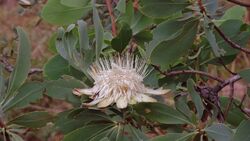Biology:Protea angolensis
| Protea angolensis | |
|---|---|

| |
| Scientific classification | |
| Kingdom: | Plantae |
| Clade: | Tracheophytes |
| Clade: | Angiosperms |
| Clade: | Eudicots |
| Order: | Proteales |
| Family: | Proteaceae |
| Genus: | Protea |
| Species: | P. angolensis
|
| Binomial name | |
| Protea angolensis Welw.
| |
| Synonyms[1] | |
| |
Protea angolensis is also known as the Angolan protea,[1] northern protea[1] or northern sugarbush.[2] In Afrikaans it is known as the noordelijke suikerbos.[2] This is a dwarf, multistemmed shrub or small straggling tree occurring in open wooded grassland and miombo.[2][3]
Description
The leaves are leathery and hairless, green to bluish-green, oval-shaped, and measure 16 cm × 8 cm (6.3 in × 3.1 in) in size. The inflorescences (flowerheads) are solitary and may grow to approximately 10 cm × 12 cm (3.9 in × 4.7 in) in size,[2] sometimes smaller, 8–12 cm (3.1–4.7 in) in diameter.[1] The involucral bracts a pale green to bright pink or red colour. The inner bracts may be either heavily or sparely covered in silvery silky hairs.[2] This difference is often due to the age of the inflorescence, the hairs falling off as the structure becomes older.[1] The fruit is a densely hairy nut.[2]
GBIF recognizes three varieties:[4]
- var. divaricata: A small tree to 4 m (13 ft) in height.[2][3] Occurs in miombo. It flowers later than the nominate form, from April to July.[1] The flowers and bracts are bright pink, dark pink to red.[3]
- var. roseola
- var. trichanthera
Distribution
This species occurs in northern, central and eastern Zimbabwe,[2][5] throughout Zambia, western Angola, southern Democratic Republic of the Congo, Burundi, southern and western Tanzania,[1] northern Malawi[6] and to a limited extent in Mozambique[2] (only in Tete).[1] In Zambia it occurs throughout the country, and has been recorded in North-Western Province, Northern Province[7] (Bangweulu Wetlands),[3] Lusaka Province, Southern Province and Western Province.[7]
Ecology
The species is the host plant for the larvae of the butterflies Capys disjunctus and C. connexivus.[2]
References
- ↑ 1.0 1.1 1.2 1.3 1.4 1.5 1.6 1.7 Hyde, Mark; Wursten, Bart; Ballings, Petra; Coates Palgrave, Meg (2000). "Protea angolensis Welw. var. angolensis". Mark Hyde, Bart Wursten, Petra Ballings and Meg Coates Palgrave. https://www.mozambiqueflora.com/speciesdata/species.php?species_id=120710.
- ↑ 2.0 2.1 2.2 2.3 2.4 2.5 2.6 2.7 2.8 2.9 van Wyk, Braam; van Wyk, Piet (1997). Field Guide to trees of South Africa. Cape Town: Struik. p. 212, 213. ISBN 1-86825-922-6.
- ↑ 3.0 3.1 3.2 3.3 Huchzermeyer, Carl (February 2011). "Zambian plants". Carl Huchzermeyer. https://bangweulufish.wordpress.com/zambian-plants/.
- ↑ "Protea angolensis Welw." (in en). https://www.gbif.org/species/7287704.
- ↑ Hyde, Mark; Wursten, Bart; Ballings, Petra; Coates Palgrave, Meg (2000). "Protea angolensis Welw. var. angolensis". Mark Hyde, Bart Wursten, Petra Ballings and Meg Coates Palgrave. https://www.zimbabweflora.co.zw/speciesdata/species.php?species_id=120710.
- ↑ Hyde, Mark; Wursten, Bart; Ballings, Petra; Coates Palgrave, Meg (2000). "Protea angolensis Welw. var. angolensis". Mark Hyde, Bart Wursten, Petra Ballings and Meg Coates Palgrave. https://www.malawiflora.com/speciesdata/species.php?species_id=120710.
- ↑ 7.0 7.1 "Flora of Zambia: Species information: Protea angolensis var. angolensis". https://www.zambiaflora.com/speciesdata/species.php?species_id=120710.
Wikidata ☰ Q2157949 entry
 |

